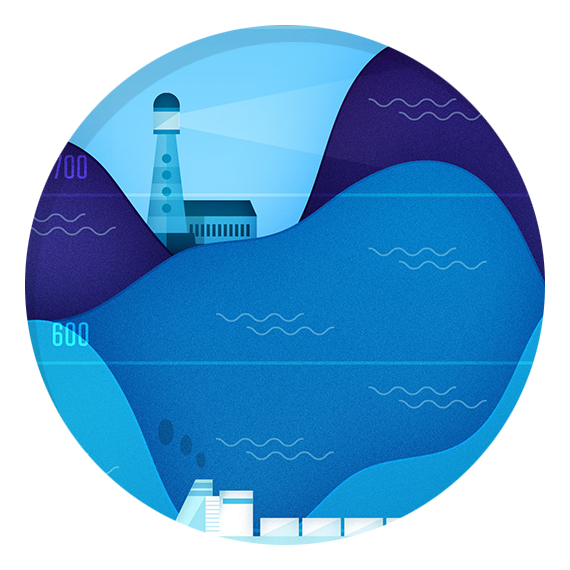Research is a prerequisite for blue growth

What do we actually mean with blue growth, Head of Unit Jari Haapala? "Blue growth is a long-term strategy to support the growth of maritime livelihood as a whole so that the utilization of marine resources are sustainable for the environment. The Baltic Sea is significant for the Finnish economy, and the sea offers many opportunities for different sectors. It is Finland's blue gold.
More information about the Baltic Sea with marine observations
The sustainable use of maritime resources requires that we research the sea and maritime operations concurrently from different viewpoints. Marine observations are basement for the success of blue growth. The flagship of marine research at the Finnish Meteorological Institute is the marine research station on the island of Utö that produces real-time research data on the sea, its surface and the air year-round and around the clock on a long-term basis. The basic concept for Utö is a comprehensive approach that gives an overall picture of the state of the sea and the lower atmosphere."The Baltic Sea is a small and shallow peripheral sea that functions differently from the oceans. The sea is also affected by variables such as marine biological processes, temperature, nutrients, waves and ice cover. Understanding the whole requires a wide array of measurements", says Lauri Laakso, Head of Group at the Finnish Meteorological Institute. The Utö measurement station is a part of the European ICOS (Integrated Carbon Observation System) network.The Finnish Meteorological Institute is also involved in the FINMARI infrastructure whose aim is to develop joint, automatized real-time tools for marine research. In this way, research and the monitoring of the marine environment can be better served to support decisions regarding the environment. The Finnish Meteorological Institute has recently acquired its first robotic underwater glider equipped with multidisciplinary sensors. The glider opens new possibilities, including more accurate assessment of the future of the Baltic Sea.

Kuva: Kimmo Tikka
Special characteristics of sea areas must be taken into account
The sustainable use of seas requires up-to-date data on the state of the sea, but also understanding how human actions affect marine conditions on the scale of decades. The objective of the recently started SmartSea project is to assess how the Gulf of Bothnia will change in the next decades. This way, we can prepare for and predict the changes and subsequent needs of different trades.
In the multidisciplinary joint project, the task of the Finnish Meteorological Institute is to research the effect of climate change on the marine ecosystem and to assess the risks of human actions and societal obstacles complicating sustainable development. SmartSea also studies how marine operations, such as the production of wind energy, can be realised without stressing the marine environment.
"The Gulf of Bothnia is a risk area where climate change significantly affects conditions such as salinity, therefore affecting the entire marine population. The rapid growth of the commercial marine activities, such as wind power and fish farming, and the consequences of climate change may lead to conflicts between different operations and harm the marine ecosystem at the Gulf of Bothnia", reminds SmartSea project leader Jari Haapala.
Clean and safe traffic imperative for blue growth
The growth of maritime traffic is one of the risks of blue growth in the Baltic Sea due to accidents as well as emissions. The Baltic Sea is Finland's most important transport way, with over 90% of Finnish goods being transported using the sea.
The marine services of the Finnish Meteorological Institute produce real-time observations, forecasts and analyses and expert services for maritime traffic. Most commonly used services include the Ice Service and the sea level and wave height services. These are vital safety services for nearly all marine operators from fishermen to ship traffic.The Finnish Meteorological Institute is currently also running several projects related to maritime transport emissions. "It's vital that we first get a comprehensive picture of shipping emissions, so that we can assess their impacts as well as make plans for restrictions and monitoring," explains Jukka-Pekka Jalkanen, Senior Researcher at the Finnish Meteorological Institute. There are excellent opportunities for reducing maritime transport emissions. Technical solutions for reducing both air pollution and greenhouse gas emissions are available, but they still require additional research. "Although many shipping lines have already switched to more environmentally-friendly fuels, there is still no precise data available on the overall impact of these solutions. The Envisum project has developed indicators and models for the assessment of shipping emissions, their environmental and health impacts and emissions restriction methods", tells Jalkanen.
"Research using different viewpoints improves Finland's potential to sustainably benefit from the marine resources. Economic interests will be directed towards the Arctic Ocean, and I am sure that this kind of expertise will be useful there in the coming years", summarises Jari Haapala.